ASUS N53JF: Midrange 15.6” 1080p, Take Four
by Jarred Walton on December 28, 2010 1:40 AM ESTASUS N53JF: Performs as Expected
Performance is pretty much right where you’d expect, given the hardware. It has the same GT 425M GPU as the Clevo B5130M and the i5-460M CPU is fractionally faster than the i5-450M in the XPS 15, so performance typically falls in between the two. Battery life is somewhat hampered by ASUS’ continued use of 48Wh batteries in their N-series, something we’ve complained about in the past. The U-series’ 84Wh batteries don’t feel much heavier than the 48Wh, and size is close enough that a slight reworking of the N53JF could have accommodated the larger battery. However, ASUS does do a reasonable job at power management, so even with a smaller battery than the competition it remains competitive. Here are the application results, followed by gaming and battery life.
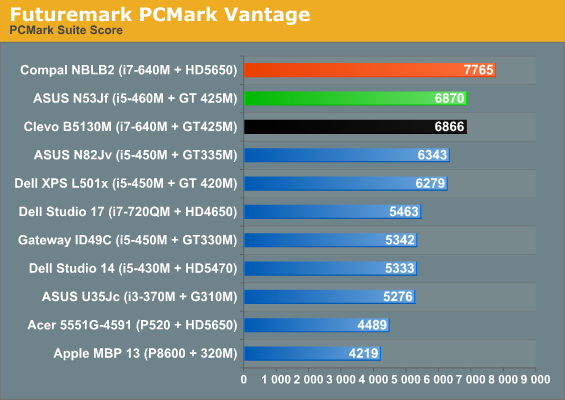
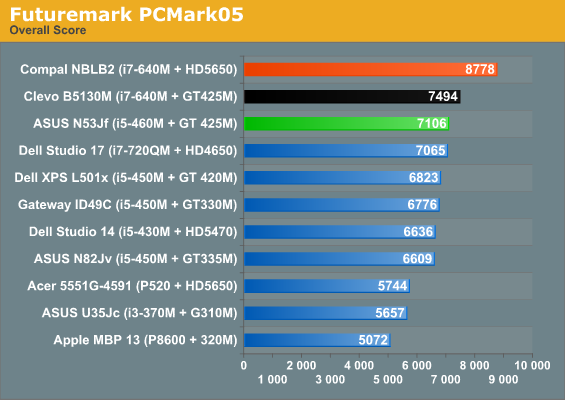
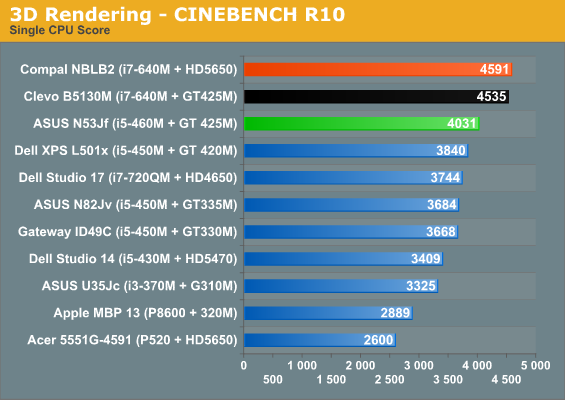
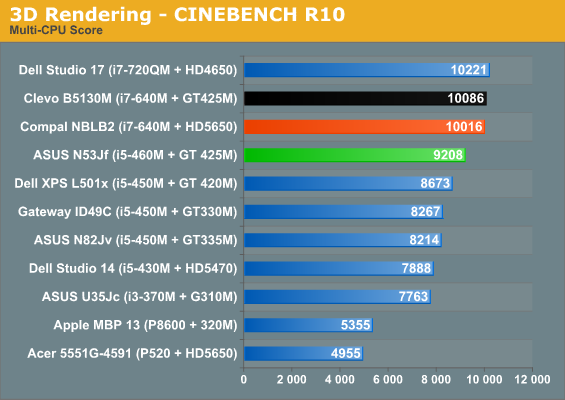
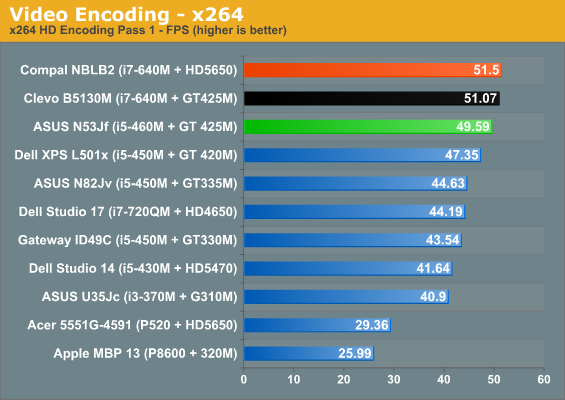

Starting with these general performance metrics, the N53JF is usually about 5% faster (sometimes as much as 10%) than the XPS 15, which goes with the CPU upgrade, with perhaps a few extra performance optimizations by ASUS. The Clevo and Compal laptops both have a faster i7-640M CPU so they come out ahead, but other differences come into play. In PCMark, the Clevo and ASUS laptops are nearly equal, but the Compal comes out 13% faster in Vantage and 23% faster in PCMark05—perhaps thanks to the HD 5650 discrete GPU. Once we hit the pure CPU tests of 3D rendering and video encoding, the charts fall into line and the i7 CPU outpaces the i5-460M by 8-10%.
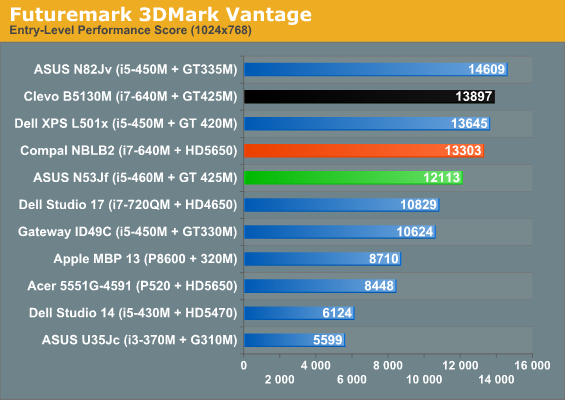
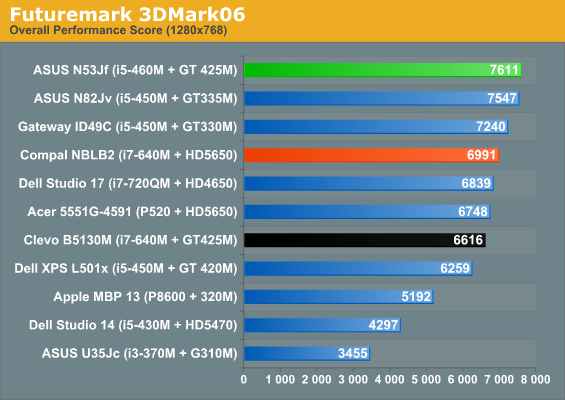
3DMark numbers aren’t a major focus for us, for good reason. Here we see the N53JF leading by up to 22% in 3DMark06, but then it trails by up to 15% in Vantage. Yeah, go figure. The Performance score in Vantage is 3559 for the curious. The 3DMark03/05 numbers aren’t any better (no graphs on those): 16612 in 03 and 13397 in 05 put it slightly ahead of the Clevo and Dell laptops, but the HD 5650 is 3% faster in 05 and 30% faster in 03. The reason for the large lead in 03 is that Optimus appears to be a bottleneck on ultra-high frame rates; the PCIe bus gets saturated, so when you start to try and push more than ~150FPS (i.e. in the Wings of Fury benchmark) you hit a hardware frame rate bottleneck. Given the level of hardware and the frame rates where this manifests, however, it’s nothing we’re concerned about—it should only show up in older titles that really don't stress the GPU much.










65 Comments
View All Comments
JarredWalton - Tuesday, December 28, 2010 - link
I do wipe off fingerprints, but those glossy bezels pick up every little touch and the flash photography tends to bring them out more than usual. You're not seriously going to complain about one photo (out of a couple dozen) where a few fingerprints are somewhat visible, are you?therealnickdanger - Tuesday, December 28, 2010 - link
I dunno, I took time out of my busy day at work to read an article about a laptop I didn't know existed 10 minutes ago and probably will never buy anyway because the perfect laptop that I want doesn't exist/costs too much. It really bothers me that you didn't take more time to be professional and do it perfect. Now I'm going to be tormented for the rest of the day about that photo and my overall productivity is going to suffer. Thanks a lot. BTW, Merry Christmas and Happy New Year, jerks.<hopefully obvious sarcasm>
DanNeely - Tuesday, December 28, 2010 - link
I disagree. Years of simply saying glossy sucks when it's where it'll get fingerprints on it hasn't hammered the point home to the PHBs who write the laptop design specs. Perhaps if reviewers all start showing pictures of how disgusting it ends up looking after a week or two of use the point will finally get through.hybrid2d4x4 - Wednesday, December 29, 2010 - link
That's actually not a bad idea, but very ballsy/risky. I could see the manufacturers getting pissed at the 1st site that did that, stop sending them review units, and then no other site would do it out of fear of getting the cold shoulder. Then again, they don't seem to care about reviewers ranting about these issues in text, so maybe I'm worried over nothing. More likely, though, mfg's don't actually bother to read reviews of their own products...KZ0 - Tuesday, December 28, 2010 - link
"Mafia 2 manages 35FPS at 769p and 21.5FPS at 1080p"Guessing you meant 768p.
Thanks for another good review.
radium69 - Tuesday, December 28, 2010 - link
When are you going to contact MSI, to review their G series? Especially the older GX740.Can't beat the value and the performance ;)
It's a shame you guys,seem totally ASUS minded the last couple of months...
cgeorgescu - Tuesday, December 28, 2010 - link
People... full HD on a regular 22" makes for 100ppi, that's pretty comfortable, but on 15.6 it means 141ppi, that's a lot of pixels per inch. Don't tell me about the font scaling in Win7 cause FullHD@125% displays exactly like 1600x900@100%, no advantage if all screen elements are bigger, I don't get any extra screen real estate. Plus that the scaling doesn't work with all apps, there are plenty who don't scale at all.I'm very used with 1400x1050@15", 116ppi, but I wouldn't stand 141ppi all day long. Am I having problems with my eyes, is everybody else comfortable with fullHD on 15.5 (usage of 12h/day)?
DanNeely - Tuesday, December 28, 2010 - link
I'm not. 1600x900 seems to be a lot rarer on 14/15" laptops than 1680x1050 was a few years ago. For that matter, has anyone reviewed the current crop of 1600x900's to see if they're good panels like most of the 1920x1080's or garbage like the 1366x768s?JarredWalton - Tuesday, December 28, 2010 - link
The two 1600x900 displays I've seen in the last year are both junk. I also think 1080p on 15.6" will be a stretch for the over-40 crowd, but I'm okay with it. Those who suggest we need 4K screens on laptops, though... I have problems with a 30" LCD at 2560x1600; what would it be like to have that resolution in 1/4 the area!?DanNeely - Tuesday, December 28, 2010 - link
Enough DPI that AA won't be needed much. GPUs capable of pushing that many pixels are some years down the pipeline though. According to the Eyefinity lead at ATI 3x25 mega pixel monitors placed to completely fill your field of view would have a high enough DPI that you'd be unable to resolve individual pixels with your eyes. At typical laptop distances an 8MP screen would probably be approaching that level.